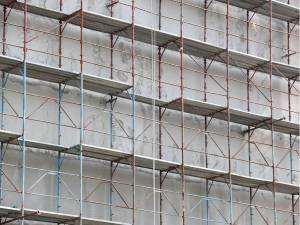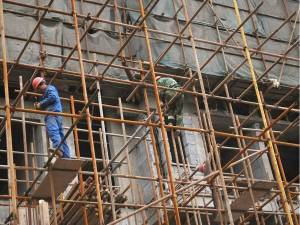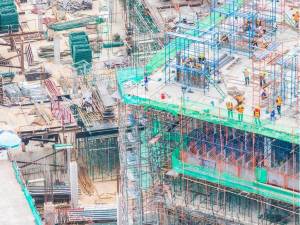
Scaffolding is a temporary structure in the construction industry that supports workers and materials, offering a safe and stable platform for tasks at heights. It’s essential for accessing hard-to-reach areas and comes in various types to meet specific project needs.
Types of Scaffolding and Their Uses
Scaffolds are usually made from metal poles, tubes, and planks that create a sturdy platform for workers to stand on while performing their tasks. However, there are different types of scaffolding used in construction projects depending on the specific requirements and conditions.
Tubular Scaffolding and Coupler Scaffold
Steel scaffolding, also known as tubular and coupler scaffolding, consists of steel or aluminium tubes connected by couplers. This type of scaffolding is highly flexible and can be assembled in various configurations to suit different construction needs.
- Tubes: These form the main framework and are available in various lengths and diameters.
- Couplers: These are the fittings that connect the tubes. There are different types of couplers, including right-angle couplers, swivel couplers, and sleeve couplers, each serving a specific purpose.
- Base Plates: These provide a stable foundation for the scaffolding, distributing the load evenly.
- Ledgers and Transoms: Ledgers are horizontal tubes that connect the standards (vertical tubes), while transoms are placed at right angles to the ledgers to support the working platform.
Steel scaffolding is versatile and can be used for various construction and maintenance tasks, including building facades, bridges, and industrial structures. Its flexibility allows it to be adapted to different shapes and heights, making it suitable for complex projects.
Cantilever Scaffolding
Cantilever scaffolding is a type of scaffolding that extends from a building, supported by needles or cantilever beams. This type of scaffolding is used when the ground cannot support standards, such as on busy streets or when working on upper floors of buildings.
- Needles (Cantilever Beams): These are horizontal beams inserted into the building to support the scaffold.
- Standards: Vertical tubes that transfer the load to the ground.
- Ledgers and Putlogs: Ledgers are horizontal tubes that connect the standards, while putlogs are horizontal tubes that connect the scaffold to the building.
- Braces: Diagonal tubes that provide stability to the scaffold.
Cantilever scaffolding is commonly used for tasks that require access to hard-to-reach areas, such as working on upper floors of buildings or over obstacles like streets and pavements. It provides a stable platform without the need for ground support, making it ideal for urban construction projects.
Aluminium Mobile Scaffolding
Aluminium mobile scaffolding is a lightweight and portable scaffolding system made from aluminium. It is designed for easy movement and quick assembly.
- Aluminium Frames: Lightweight frames that form the main structure.
- Wheels: Casters that allow the scaffold to be moved easily from one location to another.
- Adjustable Platforms: Platforms that can be adjusted to different heights to suit various tasks.
- Braces and Guardrails: Braces provide stability, while guardrails ensure worker safety.
Aluminium mobile scaffolding is ideal for tasks that require frequent movement, such as painting, electrical work, and maintenance in various industries. Its mobility and ease of assembly make it highly convenient for short-term projects and tasks that require access to multiple locations.
Another lightweight and portable option is trestle scaffolding, which uses movable tripods or ladders to support the working platform, making it ideal for indoor projects and tasks that require a limited height of up to 5 metres.
Modular System Scaffolding
Modular system scaffolding consists of pre-engineered components that can be assembled in various configurations. This type of scaffolding is designed for flexibility and efficiency.
- Vertical and Horizontal Frames: These frames form the main structure and can be connected in different configurations.
- Diagonal Braces: These provide stability to the scaffold.
- Modular Connectors: These connectors allow the frames to be easily assembled and disassembled.
- Platforms: Working surfaces that can be placed at different heights.
Modular system scaffolding is commonly used in complex construction projects, due to its flexibility and ability to adapt to different structures. It is also used in projects that require frequent changes in scaffold configuration, as the modular components can be quickly reassembled.
Another type of pre-engineered scaffolding system is patented scaffolding, which is known for its easy assembly, safety features, and adjustable working platform, making it ideal for short-term repair work.
Frame Type Scaffolding
Frame type scaffolding, also known as H-frame scaffolding, consists of welded frames that support platforms. This type of scaffolding is known for its simplicity and ease of use.
- H-Shaped Frames: These frames form the main structure and provide support for the platforms.
- Cross Braces: These braces connect the frames and provide stability.
- Platforms: Working surfaces that can be placed at different heights.
- Base Plates: These provide a stable foundation for the scaffold.
Frame type scaffolding is widely used in residential and commercial construction projects for tasks like plastering, painting, and masonry work. Its simple design allows for quick assembly and disassembly, making it ideal for projects that require frequent scaffold setup and takedown.
Another type of simple and easy-to-use scaffolding is single scaffolding, which is primarily used in brick masonry work and consists of vertical standards, ledgers, and putlogs.
Types of Suspended Scaffolding
Suspended scaffolding is a platform suspended from the roof or upper structure of a building by ropes or chains. This type of scaffolding is used for tasks that require access to high-rise buildings.
- Platform: The working surface that is suspended from the building.
- Suspension Ropes or Chains: These support the platform and allow it to be raised or lowered.
- Hoist Mechanism: A system that allows the platform to be moved up and down.
- Guardrails: Safety features that prevent workers from falling off the platform.
Types of suspended scaffolding:
- Single-Point Suspended Scaffold: Supported by a single rope or chain, typically used for light tasks.
- Two-Point Suspended Scaffold: Supported by two ropes or chains, providing a more stable platform for heavier tasks.
- Multi Point Suspended Scaffold: Supported by multiple ropes or chains, used for large platforms and heavy-duty tasks.
Suspended scaffolding is ideal for high-rise building maintenance, window cleaning, and exterior painting. It provides access to areas that are difficult to reach with other types of scaffolding and allows workers to perform tasks at various heights safely.
OSHA Rules for Scaffolding

In Malaysia, the safety of workers on construction scaffolding is a key concern, regulated by the Department of Occupational Safety and Health (DOSH) under the Factories and Machinery Act 1967 and Occupational Safety and Health Act of 1994 (OSHA 1994).
General Safety Requirements
Scaffolding must be designed by a registered engineer to support at least four times the maximum load, ensuring stability. Safe access should be provided via ladders, stairs, or ramps, and guardrails installed on platforms over 2 metres high. Platforms must be fully planked, with minimal gaps to prevent tripping hazards.
Training Requirements
Scaffold erectors and dismantlers must receive training on hazard identification, fall protection, and PPE use, ensuring competence in scaffolding tasks. Scaffold users require training on hazards, safe practices, and emergency responses, with regular refreshers to stay updated on safety standards.
Inspection Requirements
Regular inspections by a competent person are vital for scaffolding safety, occurring before each shift and after events impacting integrity. Inspections assess structural integrity, proper assembly, and condition of components, addressing any issues immediately. Documentation of inspections, including dates, inspector names, and actions taken, ensures compliance with safety regulations and demonstrates due diligence.
Compliance and Penalties
Adhering to DOSH regulations for scaffolding is crucial for ensuring worker safety and avoiding penalties, such as fines and legal action. Compliance enhances productivity by preventing accidents and fosters a workplace safety culture, leading to fewer accidents, lower insurance costs, and improved morale.
Get a Scaffolding from Asia Warehouse

Selecting the right scaffolding is vital for safety and efficiency in a construction project. Options vary, such as bamboo for eco-friendliness, double scaffolding for stone-masonry, tubular for versatility, cantilever for hard-to-reach areas, and aluminium mobile scaffolding for frequent movement.
Asia Warehouse offers a wide range of high-quality scaffolding solutions focused on safety and durability. Our products support construction workers, ensuring efficient and secure project completion. Contact us today to find your perfect solution.
